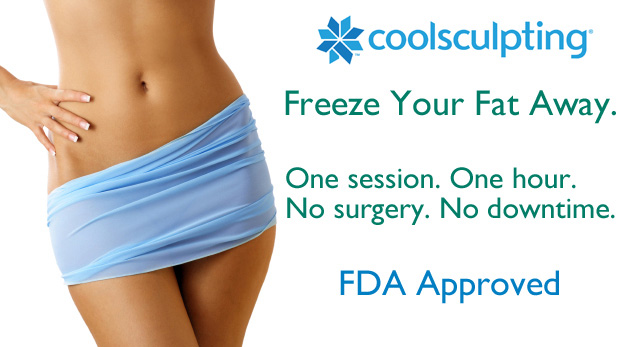
Diet and exercise is key for health promotion. Many people who eat healthy and exercise regularly – while reaping health benefits – still are struggling to lose some stubborn body fat. For this, CoolSculpting comes to the rescue.
CoolSculpting has become one of the most popular non-surgical alternatives to liposuction for spot reduction of stubborn body fat.[1] Thousands of CoolSculpting procedures are performed around the world every day, and it was nominated by Allure magazine in July 2015 as the latest trend in beauty.
By applying prolonged, controlled local skin cooling, CoolSculpting induces selective damage and subsequent loss of subcutaneous fat, without damaging the overlying skin [2], and is FDA approved for localized fat reduction and body contouring.
In this article we summarize the results from a systematic review of available clinical data up to 2015 on the efficacy and safety of CoolSculpting.[3]
Efficacy
Treatment areas in the included studies were the abdomen [4-7], love handles and muffin tops (hip rolls/flanks) [4, 5, 8, 9], inner thighs [4, 7], low back fat (lumbar rolls) [4], buttock fat [7], arm fat (peritrochanteric areas) [10], bra fat (brassiere rolls)[4] and inner knee fat (medial knee).[4]
Follow-up length generally ranged from 2 to 6 months, although one study presented case reports on two patients at 2 and 5 years after treatment.[11] This study examined the long-term visibility of fat layer reduction after CoolSculpting. Subjects were unilaterally treated on one flank, i.e. the “love handle” on one side was treated. Baseline and post-procedure photographs (at 2 or 5 years) of the treated and contralateral untreated sides showed durable results despite natural fluctuations in body weight.[11]
All these studies used objective measurement methods; fat caliper, ultrasound and three-dimensional imaging. Every study referenced above using these outcome measures noted a significant reduction in fat volume in treatment areas.
While outcomes varied greatly based on treatment site and study design – which would be expected - average reduction in fat thickness measured by caliper ranged from 14.7% to 28.5%.[3] Average reduction by ultrasound ranged from 10.3%to 25.5%.[3]
In all cases, high satisfaction rates were noted, as demonstrated by post-treatment patient satisfaction
surveys.[3]
Does post-treatment massage improve results?
The effect of post-treatment massage was evaluated in two studies. One study evaluated 5 minutes of post-treatment massage, noting an average fat reduction of 21.5% in treated areas by caliper measurement at 6 months.[4]
Another study compared patients receiving 2 minutes of post-treatment manual massage to a control group receiving only the standard CoolSculpting treatment without massage.[6] At 2 months after treatment, average fat layer reduction was 68% greater on the massaged side (12.6% on the non-massaged side versus 21% on the massaged side).[6]
Safety and Complications
In studies that evaluated lipid levels and liver function tests, no significant impact was noted on lipid levels or liver function tests after CoolSculpting.[7, 12]
Common complications noted after CoolSculpting included erythema, bruising, swelling and sensitivity.[3] These side effects are generally resolved within a few weeks after treatment. No persistent ulcerations, scarring, paresthesias, hematomas, blistering, bleeding, hyperpigmentation or hypopigmentation, or infections have been experienced after CoolSculpting treatment.
Summary
CoolSculpting is a promising procedure for non-surgical fat reduction and body contouring and presents a compelling alternative to liposuction and other, more invasive methods.
Data shows that CoolSculpting is safe and effective for localized reductions of stubborn body fat areas, with body fat reduction ranging up to almost 30%. The fat reductions are measurable, visible and durable.
If you have any questions, call us 702-838-1994 or submit the form.
At Ageless Forever you get manual massage after each treatment in order to further increase your fat loss and body contouring effect.
References:
1. Jalian, H.R. and M.M. Avram, Cryolipolysis: a historical perspective and current clinical practice. Semin Cutan Med Surg, 2013. 32(1): p. 31-4.
2. Manstein, D., et al., Selective cryolysis: a novel method of non-invasive fat removal. Lasers Surg Med, 2008. 40(9): p. 595-604.
3. Ingargiola, M.J., et al., Cryolipolysis for fat reduction and body contouring: safety and efficacy of current treatment paradigms. Plast Reconstr Surg, 2015. 135(6): p. 1581-90.
4. Sasaki, G.H., N. Abelev, and A. Tevez-Ortiz, Noninvasive selective cryolipolysis and reperfusion recovery for localized natural fat reduction and contouring. Aesthet Surg J, 2014. 34(3): p. 420-31.
5. Shek, S.Y., N.P. Chan, and H.H. Chan, Non-invasive cryolipolysis for body contouring in Chinese--a first commercial experience. Lasers Surg Med, 2012. 44(2): p. 125-30.
6. Boey, G.E. and J.L. Wasilenchuk, Enhanced clinical outcome with manual massage following cryolipolysis treatment: a 4-month study of safety and efficacy. Lasers Surg Med, 2014. 46(1): p. 20-6.
7. Ferraro, G.A., et al., Synergistic effects of cryolipolysis and shock waves for noninvasive body contouring. Aesthetic Plast Surg, 2012. 36(3): p. 666-79.
8. Garibyan, L., et al., Three-dimensional volumetric quantification of fat loss following cryolipolysis. Lasers Surg Med, 2014. 46(2): p. 75-80.
9. Coleman, S.R., et al., Clinical efficacy of noninvasive cryolipolysis and its effects on peripheral nerves. Aesthetic Plast Surg, 2009. 33(4): p. 482-8.
10. Pinto, H.R., E. Garcia-Cruz, and G.E. Melamed, A study to evaluate the action of lipocryolysis. Cryo Letters, 2012. 33(3): p. 177-81.
11. Bernstein, E.F., Longitudinal evaluation of cryolipolysis efficacy: two case studies. J Cosmet Dermatol, 2013. 12(2): p. 149-52.
12. Riopelle, J.T. and B. Kovach, Lipid and liver function effects of the cryolipolysis procedure in a study of male love handle reduction. Lasers Surg Med, 2009. 82.




